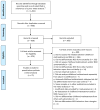Childhood maltreatment and non-suicidal self-injury: a systematic review and meta-analysis
- PMID: 29196062
- PMCID: PMC5743605
- DOI: 10.1016/S2215-0366(17)30469-8
Childhood maltreatment and non-suicidal self-injury: a systematic review and meta-analysis
Abstract
Background: Non-suicidal self-injury is being increasingly recognised as a prominent public health concern. Identification of early and modifiable risk factors is necessary to advance the screening and intervention efforts, particularly early detection of at-risk individuals. We aimed to examine childhood maltreatment, including its specific subtypes, in relation to non-suicidal self-injury.
Methods: We did a comprehensive meta-analysis of childhood maltreatment (overall, sexual abuse, physical abuse and neglect, and emotional abuse and neglect) in association with non-suicidal self-injury. We also provided a qualitative review of mediators and moderators of this association. We identified relevant articles published from inception to Sept 25, 2017, through a systematic search of Embase, MEDLINE, and PsycINFO. We extracted continuous and categorical data and assessed for potential moderators using ten study characteristics. We generated random-effects models for analysis and evaluated for publication bias.
Findings: We identified 71 publications that met eligibility criteria. Overall childhood maltreatment was associated with non-suicidal self-injury (odds ratio 3·42, 95% CI 2·74-4·26), and effect sizes for maltreatment subtypes ranged from 1·84 (1·45-2·34) for childhood emotional neglect to 3·03 (2·56-3·54) for childhood emotional abuse. Publication bias was not evident, except in the case of childhood emotional neglect. Across multiple maltreatment subtypes, we found stronger associations with non-suicidal self-injury in non-clinical samples.
Interpretation: With the exception of childhood emotional neglect, childhood maltreatment and its subtypes are associated with non-suicidal self-injury. Screening of childhood maltreatment history in non-suicidal self-injury risk assessments might hold particular value in community settings, and increased attention to childhood emotional abuse is warranted.
Funding: National Institute of Mental Health.
Copyright © 2017 Elsevier Ltd. All rights reserved.
Figures







Comment in
-
Childhood maltreatment and non-suicidal self-injury: clinical implications.Lancet Psychiatry. 2018 Jan;5(1):5-6. doi: 10.1016/S2215-0366(17)30470-4. Epub 2017 Nov 28. Lancet Psychiatry. 2018. PMID: 29196063 No abstract available.
References
-
- Nock MK. Self-injury. Annu Rev Clin Psychol. 2010;6:339–63. - PubMed
-
- Swannell SV, Martin GE, Page A, Hasking P, St John NJ. Prevalence of nonsuicidal self-injury in nonclinical samples: Systematic review, meta-analysis and meta-regression. Suicide Life-Threatening Behav. 2014;44:273–303. - PubMed
-
- Whitlock J, Eckenrode J, Silverman D. Self-injurious behaviors in a college population. Pediatrics. 2006;117:1939–48. - PubMed
Publication types
MeSH terms
Grants and funding
LinkOut - more resources
Full Text Sources
Other Literature Sources
Medical
Miscellaneous

